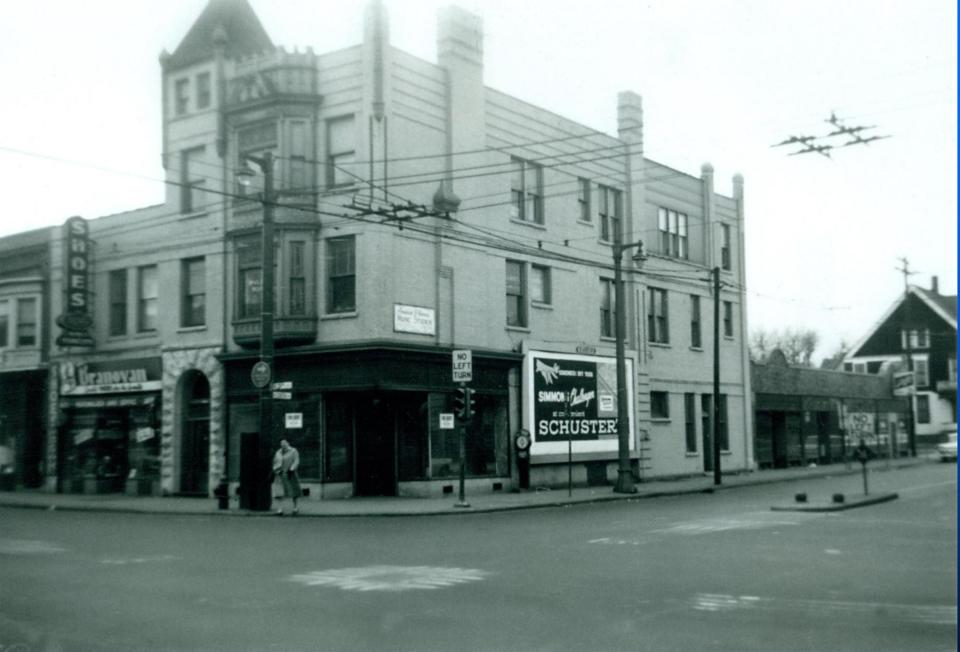Milwaukee looking for developers for historic Bronzeville building, but gets no takers
- Oops!Something went wrong.Please try again later.
Efforts to attract developers to revitalize a century-old building on the corner of King Drive and Center Street may be hampered by the building’s landmark status.
Concerns about the long-vacant Hummel/Uihlein Building’s landmark status and its impact on potential developers topped the discussions at the Bronzeville Advisory Committee’s monthly meeting Monday.
The city wants to redevelop this architecturally significant building located at 2673-79 N. King Dr. The city-owned property has been on the market since January 2022 but has had no takers. The asking price is $10,000.
“There is a hope for something to happen for it (the building),” said LaShawndra Vernon, the committee’s chair. “But there are challenges that developers are articulating back to the Department of City Development that include that high cost of meeting the standards of historically preserved buildings.”
Designated as a historic landmark in July 2010, the building was constructed by prominent architect Charles Kirchhoff in 1889. The three-story cream city brick building is noted for its Romanesque revival style, a signature feature of Kirchhoff, who designed several taverns for the Schlitz Brewing Company.

These buildings were constructed only for a brief period in Milwaukee’s history, said Andrew Stern, a senior planner with the city’s Historic Preservation Commission. Few remain today.
Kirchhoff and his partner, Thomas L. Rose, designed some of the city’s renowned buildings, including the Schlitz Palm Garden on Third Street and Wisconsin Avenue, the Second Ward Savings Bank (now the Milwaukee County Historical Society Center) and the Empire Building (now the Riverside Theater).
Though Kirchhoff was known for designing taverns, the Hummel/Uihlein Building is a rare example of a building that didn't follow that form. The building was originally designed as a pharmacy but has had many uses over the years, including a beauty salon, a dentist's office, a shoe shop and a restaurant called the Fireside Lounge.
Stern noted the landmark status puts constraints on a developer going through the “certificate of appropriateness” process. Certain guidelines must be followed for any exterior work on the building to ensure it doesn’t harm its historic character, he said.
Amy Turim with the Department of City Development said the building has extensive interior damage, including missing floorboards. The city, she added, is offering a preservation grant of up to $50,000 to facilitate historical renovation requirements. She added investment in the building will bring it back to productive use and contribute to the vibrancy of the community.
Since this property is historic, Turim said similar materials should be used as the original for exterior work. If the property originally had wood windows, then the rehab work should also include wood windows, she said.
But she admitted that keeping like-for-like materials might be a challenge for novice developers. The building has cream city brick exterior walls and ornate detailing near the roofing line. To fix the roof alone, Turim said, could cost close to $234,000.
The developers who have viewed the property indicated the scope of work is too much, Turim said.
“I don’t know if that’s necessarily pertaining to the historical requirements or the condition of the building,” she said. “But the feedback has been consistent that the level of work that the property needs is too extensive for them to take on.”
Ald. Milele Coggs said the department should seek funding from the state’s pot of American Rescue Plan Act, or ARPA, funding to rehab historic buildings that have more challenging work. The state, she said, still has money it needs to allocate or return to the federal government.
“This could be a way to address some of the harder-to-develop properties throughout the community — and a quicker way,” Coggs said.
Turim said the preservation grant fund hasn't received any new money for quite some time. But potential developers could get additional funding from other city grants, including $75,000 from the commercial foreclosure renovation fund to help defray costs.
Vernon of the Bronzeville committee, said she hoped the city would look at partnerships between a seasoned developer and a novice to get the project going. The building, she said, sits in a catalytic intersection, which is part of the city transit-oriented development plan.
“It is an important spot to continue to spur that development,” Vernon said.
This article originally appeared on Milwaukee Journal Sentinel: Milwaukee can't find developers for historic Bronzeville building

